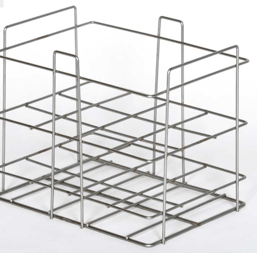Stainless steel racks are durable material handling solutions designed to support, store, and transport items in various environments. Their open design helps prevent dust and debris accumulation, while their stainless steel construction ensures protection from high temperatures and harsh sterilization processes. In the food processing industry, food-grade stainless steel racks are used in:
- Refrigeration and freezer units

- Walk-ins
- Ovens
- Carts
- Trays
- Food processing baskets
Depending on the structure and composition of the stainless steel used in the rack's construction, stainless steel racks may or may not exhibit magnetic properties. This blog discusses magnetism in stainless steel materials, specifically as it relates to the food-grade stainless steel racks used in food processing environments.
Is Stainless Steel Magnetic?
Magnetism in stainless steel is influenced by the material's microstructure combined with the presence of iron. While all stainless steels contain iron, only certain grades exhibit the specific structural arrangement required to generate a magnetic field. The three main types of stainless steel and their magnetic capabilities are detailed below.
- Ferritic: Ferritic stainless steels are magnetic due to high amounts of ferrite, a compound of iron oxide combined with other metallic elements.
- Martensitic: Certain grades of martensitic stainless steel contain enough iron in their crystalline structure to make them ferromagnetic.
- Austenitic: Austenitic stainless steels contain nickel, which creates an austenitic microstructure that renders the material non-magnetic.
Are Food Grade Stainless Steel Racks Magnetic?
Given the above information, it is clear that the magnetic potential of any stainless steel product will depend on the type of stainless steel used in its construction. Since most food-grade stainless steels are austenitic, food handling products are typically non-magnetic. One exception is kitchen knives, which are often made from magnetic martensitic stainless steel.
For food-grade stainless steel racks, non-magnetic austenitic grades are generally preferred. Stainless steel types 304 and 316 are among the most commonly used rack materials, and they each offer specific benefits depending on the application.
- 304: 304 stainless steel is a food-safe, FDA-approved alloy exhibiting exceptional corrosion resistance and durability. Relatively high amounts of chromium and nickel give 304 stainless steel a non-magnetic austenitic structure. This type of steel is also smooth and easy to clean, making it a great option for various food processing environments.
- 316: 316 stainless steel is another food-grade, non-magnetic option used in rack construction. This grade tolerates extended exposures to high temperatures and is extremely resistant to chemicals in acidic, alkaline, and high-chloride food processing environments.
Stainless Steel Wire Racks from Marlin Steel
While many types of stainless steel are inherently magnetic, most stainless steel products used in food handling applications are made from non-magnetic austenitic grades. At Marlin Steel, we use 100% American made food-safe stainless steel grades such as 304 and 316 to create custom wire racks and shelving systems for various food processing environments. Our automated manufacturing system ensures efficient and affordable production of racks suitable for ovens, refrigeration units, walk-ins, and more. For our customers, this also means fast delivery.
With our wide selection of food-grade, heat-resistant, and chemical-resistant stainless steel materials, we can create application-specific rack solutions that will meet your specific design and environmental requirements. For more information about our products, visit our stainless steel wire racks page, request a quote, or contact us today.


.gif)


